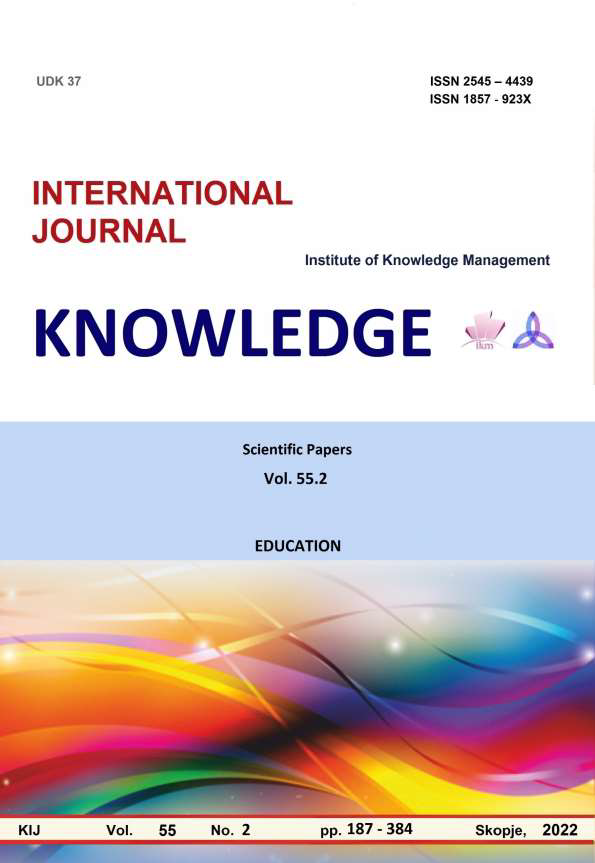THE PLACE AND ROLE OF WRITING SKILLS IN GERMAN LANGUAGE TEACHING
Keywords:
skills, interaction, writing, teachingAbstract
Writing is one of the basic cultural techniques and belongs to the basic skills, through which language is
reflected in graphic signs. Writing usually serves us to share facts, thoughts or feelings in written form. According to
Heyd, writing in foreign language teaching represents an opportunity for contact with a new, unknown structure
(1997:181). What is its function in the teaching of the German language depends on whether it represents a teaching
or intermediate goal. Writing as an intermediate goal serves us to determine the students' knowledge, rewrite or
retell texts in written form, write down new grammatical structures or new vocabulary in a notebook, etc.. On the
other hand, if we use writing in order to share some essential information, observing all language norms, we talk
about writing as a teaching goal. The skill of writing, in addition to the skills of reading, listening and speaking, is
one of the four key skills, the acquisition of which facilitates the acquisition of a foreign language and contributes to
the acquisition of communicative competences. What is the representation of the skill of writing in the teaching of
the German language and what techniques, strategies and methods are used for its successful adoption is the subject
of research in this paper. Through a previously prepared survey for a total of 26 German language teachers, we will
try to reflect the state and treatment of the skill of writing in the teaching process, as well as the representation or
non-representation of the various techniques and methods that contribute to the successful acquisition of language
competences in written form, with the hope that the obtained results will contribute to the improvement of this skill,
with the aim of easier and long-term adoption of writing as a productive skill present in our everyday life.
References
Brinitzer, M., Hatschel, H-J., Kroemer, S., & Ros. L. (2016). DaF unterrichten. Basiswissen Didaktik Deutsch als Fremd- und Zweitsprache. Stuttgart: Klett Verlag
Daskalovska, N., & Hadzi-Nikolova, A. (2020). Teacher Roles in Foreign Language Instruction. Knowledge - International Journal, Scientific Papers, 41 (2). pp. 371-376
Gehring, W. (2018). Fremdsprache Deutsch unterrichten. Bad Heilbrunn. Julius Klinkhardt
Gerdes, M. (1984). Themen 1. Lehrhandbuch 1. Ismaining: Hueber Verlag
Glück, H. (1988). Schreiben in der Fremdsprache Deutsch, in: Texte schreiben im GermanistikStudium. München: Iudicium Verlag, 25-43 6.
Gröschl, R (1986). Die Entwicklung des Schreibens, in: Didaktik des Fremdsprachenunterrichts. Leipzig: VEB Verlag Enzyklopädie, 291-304
Günther, H., Kniffka, G. Knoop, G. & Riecke-Baulecke, T. (2021). Basiswissen Lehrerbildung: Daf unterrichten. Kallmeyer; 2. Auflage
Heyd, G. (1997). Aufbauwissen für den Fremdsprachenunterricht (DaF). Ein Arbeitsbuch. Tübingen.
Ivanova, B., Kuzmanovska, D., & Kirova, S. (2021). Foreign language acquisition in schools. FILKO – conference proceedings
Kast, B. (1999). Fertigkeit Schreiben. (Fernstudieeinheit Deutsch als Fremdsprache). München: Langenscheidt
Knorr, D. (2019). Sprachensensibles Kompetenzmodell wissenschaftlichen Schreibens. Zeitschrift für Interkulturellen Fremdsprachenunterricht 24: 1, 165–179: https://zif.tujournals.ulb.tu-darmstadt.de/article/id/3182/ (преземено на 03.12.2022)





